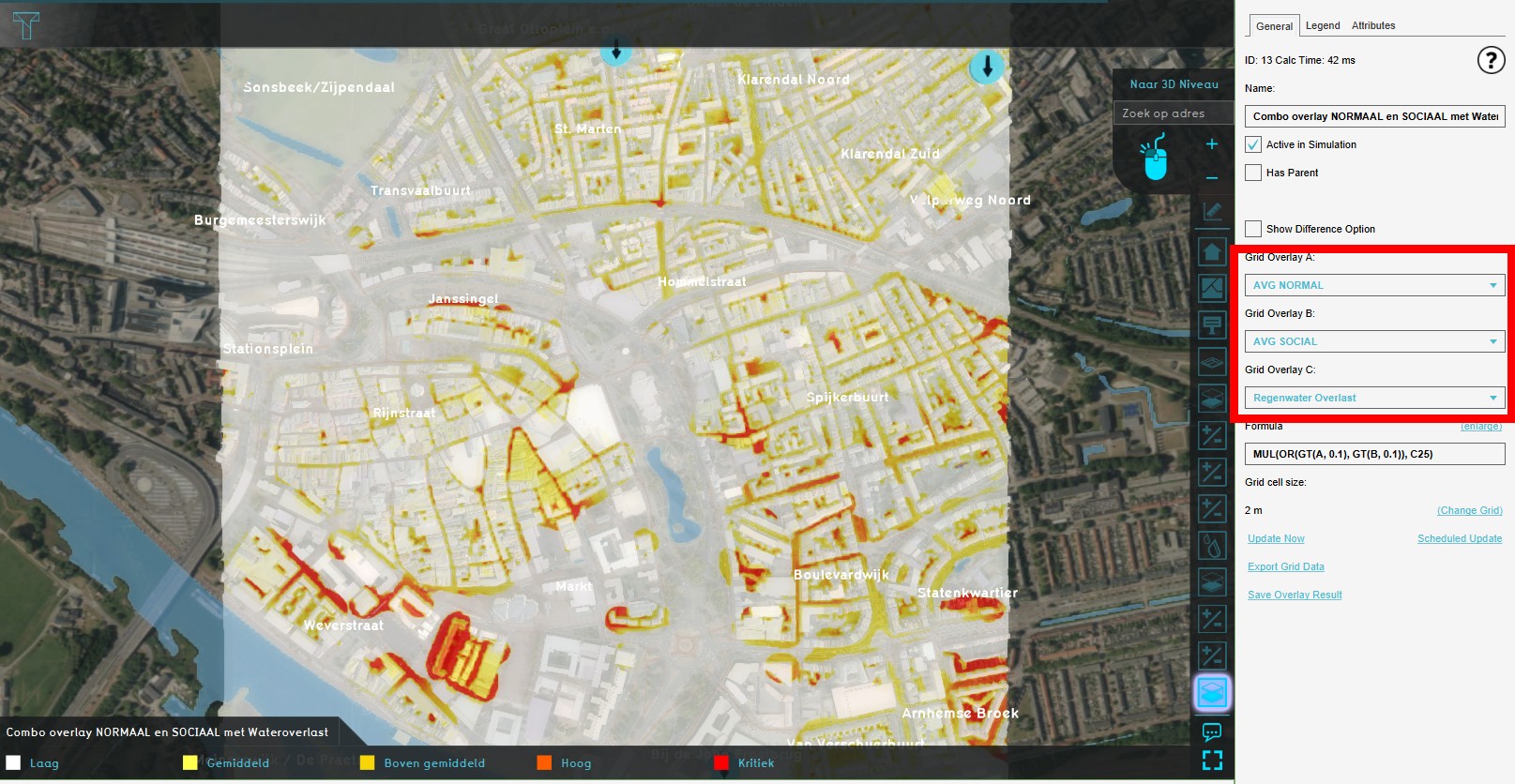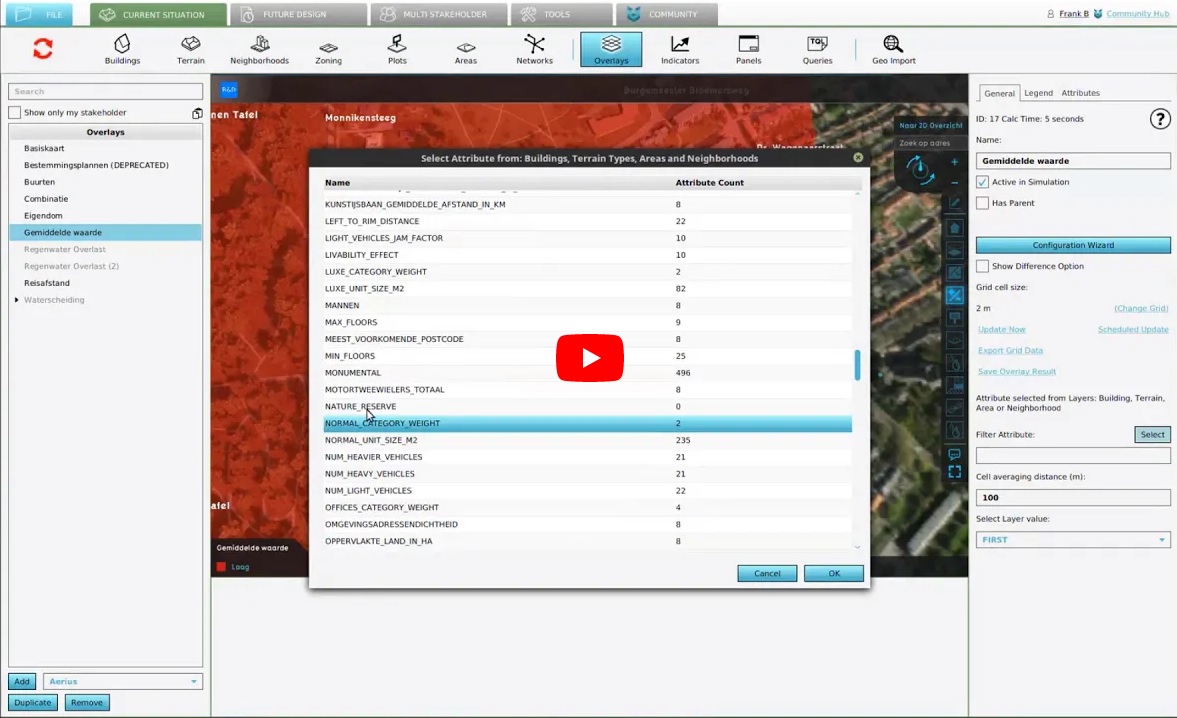Combo Overlay: Difference between revisions
Jump to navigation
Jump to search

| Line 44: | Line 44: | ||
* To query a specific timeframe add its number. E.g. A2 queries timeframe 2 from Input Overlay A. | * To query a specific timeframe add its number. E.g. A2 queries timeframe 2 from Input Overlay A. | ||
* To query multiple timeframes add start:end numbers. E.g. A1:5 is identical to "A1 A2 A3 A4 A5". | * To query multiple timeframes add start:end numbers. E.g. A1:5 is identical to "A1 A2 A3 A4 A5". | ||
* You can use [[globals|Globals]]in a formula | * You can use [[globals|Globals]] in a formula | ||
==How-to's== | ==How-to's== | ||
Revision as of 14:05, 3 March 2021

A combo overlay, combining a Rainfall Overlay with two average grid overlays (NORMAL and SOCIAL), using only the highest values in the last time frame.
The combo overlay is a grid overlay which can combine up to three grid overlays with boolean operators and use these overlays as input arguments functions and operators. The list of available functions and operators is given in the chapter below. Combo overlays can also take other combo overlays as input. Another powerful combination is the use of combo overlays with average overlays (with or without an average distance).
Operators
In the table below are the operators displayed that are supported by the combo overlay. The term argument refers to a grid overlay configured as input, a numerical value or a global name.
| Name | Arguments | Type | Displays |
|---|---|---|---|
| SIN | Single | Sine function | |
| COS | Single | Cosine function | |
| TAN | Single | Tangent function | |
| ASIN | Single | Arc sine function | |
| ACOS | Single | Arc cosine function | |
| ATAN | Single | Arc tangent function | |
| ROUND | Single | Round function | |
| FLOOR | Single | Floor function | |
| CEIL | Single | Ceil function | |
| ABS | Single | Absolute function | |
| EXP | Single | Exponential function | |
| LN | Single | The natural logarithm (base e) function | |
| LOG | Single | The natural logarithm (base 10) function | |
| SQRT | Single | The square root function | |
| RANDOM | Single | The random function, which returns a number greater than or equal to 0.0 and less than the provided argument | |
| ADD | Multi | Add one or more argument | |
| MULT | Multi | Multiply one or more arguments | |
| SUB | Multi | Subtract one or more arguments from the first argument | |
| DIV | Multi | Divide the first argument with one or more other arguments | |
| MIN | Multi | Returns the smallest of the provided arguments. That is, the result is the argument closest to negative infinity. | |
| MAX | Multi | Returns the largest of the provided arguments. That is, the result is the argument closest to positive infinity. | |
| POW | Multi | Raises the first argument to the power of the consecutive arguments. For example 2 to the power 3 to the power 4. | |
| OR | Multi | Returns 1.0 if any argument is not equal to 0.0. | |
| AND | Multi | Returns 1.0 if all arguments are not equal to 0.0. | |
| GTE | Pair | Returns 1.0 if the first argument is larger than or equal to the second argument, else returns 0.0. | |
| GT | Pair | Returns 1.0 if the first argument is larger than the second argument, else returns 0.0. | |
| LTE | Pair | Returns 1.0 if the first argument is smaller than or equal to the second argument, else returns 0.0. | |
| LT | Pair | Returns 1.0 if the first argument is smaller than the second argument, else returns 0.0. | |
| NEQ | Pair | Returns 1.0 if the first argument is not equal to the second argument, else returns 0.0. | |
| EQ | Pair | Returns 1.0 if the first argument is equal to second argument, else returns 0.0. |
Input overlays and timeframes
- Up to three overlays can be configured as input for the combo overlay. They are referenced as A, B and C.
- To query a specific timeframe add its number. E.g. A2 queries timeframe 2 from Input Overlay A.
- To query multiple timeframes add start:end numbers. E.g. A1:5 is identical to "A1 A2 A3 A4 A5".
- You can use Globals in a formula
How-to's
- How to add and remove an Overlay
- How to edit a Combo Overlay's formula
- How to edit an overlay legend
- How to add and remove an Attribute
Examples
- Combo Overlay with average overlays
- Combo Overlay with masking
- Combo Overlay with distance filtering
Seealso
